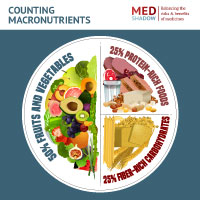Whether you want to lose, gain, or maintain weight, what you eat and drink provides the necessary fuel that your body needs—not only to survive, but to stay healthy, build muscle and be mentally sharp.
Too many people think about their diet only when they want to lose weight and in order to see results, people often turn to popular diets, including commercial options like Atkins, Whole30 and South Beach, as well as more basic eating plans like paleo, keto and Mediterranean. Other diets get even more specific, and may be tied to your blood type or focused on eating—or eliminating—very precise types of food or allergens. There are more diets, cleanses, tricks and gurus that you can possibly keep track of, and more pop up seemingly every week.
Fortunately, you don’t need to subscribe to any of the above. Because the best diet can’t be found in a book or on Instagram. Instead, diets are inherently personal, and should be tailored to the individual. That said, if you wish to change how you eat or create a long-term plan, there are proven, science-backed strategies that can help you, no matter your ambitions.
There are conditions like RA, Crohn’s, gluten intolerance and allergies for which specially tailored diets can be very effective at minimizing symptoms and improving quality of life. Most of those diets will incorporate the principles below, but follow your nutritionist or doctor’s advice in those cases.
The Basics of a Healthy Diet
There’s not a one-size-fits-all diet that works for everyone, but certain tenets apply to us all: Eat a variety of whole, nutrient-dense foods, and match your caloric intake to your body’s individual needs. That’s easier said than done, of course, but the key is to find something that works for you. A long-term eating plan that becomes part of your lifestyle will always be more beneficial than any crash diet or fad. Because dieting, as most people know it, is difficult, restrictive and doomed to fail.
“Sustainability is the biggest challenge for most people long-term,” says Amy Goodson, a Dallas-based registered dietitian. “It’s hard to follow restrictive diets. Plus, if diets cut our foods or food groups, it often makes it hard to eat with friends and family, as well as enjoy things like holidays, vacations and birthdays.”
For a basic road map, you can always consult the U.S. Department of Health and Human Services Dietary Guidelines for Americans, which provides evidence-based nutritional information and advice about making healthy food choices.
Per the guidelines, a healthy eating pattern includes:
- A variety of vegetables from all of the subgroups—dark green, red and orange, legumes (beans and peas), starchy, and others
- Fruits, especially whole fruits
- Grains, at least half of which are whole grains
- Fat-free or low-fat dairy, including milk, yogurt, cheese, and/or fortified soy beverages
- A variety of protein foods, including seafood, lean meats and poultry, eggs, legumes, and nuts, seeds, and soy products
- Oils
While most experts agree that strict limits are never wise or sustainable, there are several recommendations related to your intake of saturated fats, added sugars and sodium. The Dietary Guidelines for Americans recommends the following:
- Consume fewer than 10% of calories per day from added sugars
- Consume fewer than 10% of calories per day from saturated fats
- Consume fewer than 2,300 milligrams per day of sodium
- If alcohol is consumed, it should be consumed in moderation—up to one drink per day for women and up to two drinks per day for men
Counting Calories
If you want to manage your eating further, you can count calories, a strategy that applies whether you want to gain, lose or maintain your weight. To put it simply, if you burn more calories than you consume, you’ll lose weight. If you consume more calories than you burn, you’ll gain weight. It’s simple math, and the actual counting is a reasonably easy task when eating simple foods, but it becomes more difficult and tedious when eating multi-ingredient meals. Fortunately, there are apps (MyFitnessPal, Lose It! and Lifesum are a few of the better ones) that make it easy to calculate your target calories and track your daily diet.
“When you count calories, all foods can fit—some just fit less often or in lesser quantities,” says Goodson. “This helps people from feeling deprived, and it typically allows for longer term compliance.”
Counting calories still allows you to eat all of your favorite foods, including less-healthy options like sweets. However, sugary and high-fat foods are naturally high in calories, so eating them will burn through your allotted calories more quickly than healthier options like lean protein, fresh produce and complex carbs.
Counting Macronutrients
Macronutrients are the three types of nutrients that comprise the majority of what we eat and what our body uses for energy: protein, carbohydrates and fat. Counting macros is similar to counting calories, but with an emphasis on ensuring that you eat adequate amounts of all three groups. Ideally, this will help ensure you get the balanced nutrition and vitamin groupings you need from your food.
Athletes and fitness professionals have been focusing on macronutrients for years. But anyone can benefit from counting macros, and doing so can help you get more in-tune with what drives your hunger and satiety.
“Balancing your macros is an excellent way to help fine tune your diet and balance your eating plan to lose weight,” says Goodson. “Getting adequate protein and fat can help you feel more satisfied throughout the day and thus help you manage hunger and fullness better, as well as maintain better energy levels.”
 She adds that finding the ideal ratio and number of macros for one’s diet depends on the individual person, your size, and your fitness level. People who work out more need a different amount of carbs and protein than someone who’s more sedentary. And it’s important to note that macronutrients are also tied to specific calorie totals. Protein and carbs both have four calories per gram, while one gram of fat is nine calories.
She adds that finding the ideal ratio and number of macros for one’s diet depends on the individual person, your size, and your fitness level. People who work out more need a different amount of carbs and protein than someone who’s more sedentary. And it’s important to note that macronutrients are also tied to specific calorie totals. Protein and carbs both have four calories per gram, while one gram of fat is nine calories.
According to Goodson, a popular macro ratio is 40% carbs, 30% protein and 30% fat for those who are exercising often and looking to lose weight. Someone who wants to maintain weight might benefit from a breakdown that’s closer to 50%carbs, 25% protein and 25% fat. But these are just estimates, and they do not account for one’s weight, body composition or exercise intensity. Many apps and websites can help you calculate this, but it’s best to work with a registered dietitian to help determine your individual needs.
“Dialing in on your macros is similar to having directions to a puzzle,” says Goodson. “The more info you have to individualize it, the faster you can ideally meet your goals.” However, many people get sick of tracking food and quickly abandon the practice, so fortunately, there’s an easier way to get a rough count of your macros. “A good rule of thumb is to make half your plate veggies, one quarter lean protein and one quarter whole grains,” suggests Goodson. “Then, if you’re still hungry, fill up on more veggies.”
What Is IIFYM?
The acronym stands for “if it fits your macros,” and the idea is that, if a food fits into your macronutrient plan, then you’re free to eat it. This allows for more flexibility than many diets, since no food is off-limits.
“Technically, if you eat the right number of macros to maintain or lose weight, then you will be eating the right number of calories to meet that goal as well,” says Goodson. However, the quality of calories still matters for overall health and satiety. For instance, higher fiber whole grain carbohydrates will keep you full longer than highly processed, more refined carbohydrates. Whole grains, lean proteins and high-quality fats will also benefit your gut, heart and overall health. So, you may be able to hit your target macros by eating pizza, pasta and red meat. But that doesn’t mean you’ll necessarily be doing yourself any favors. Because while IIFYM might be an easy way to structure your eating, the quality of calories matters, and what you eat will still determine how your body feels and performs.
According to Harvard’s Nutrition Source, one medium-size apple has about 25 grams of carbs. You know what else has about 25 grams of carbs? A one-ounce serving of Skittles. These foods are not created equal, even though they will register equally when calculating your carbohydrate intake. In addition to carbs, that apple contains fiber, vitamin C and important phytochemicals that contain a host of benefits, from boosting your immune system to protecting your heart. The Skittles, meanwhile, are loaded with added sugar and artificial flavors and colors. Sure, you can eat some when the craving strikes, but it’s important to remember that counting macros or adhering to the IIFYM diet plan is not a substitute for eating nutritious foods.
Finding Long-Term Success
Dieting as a solution to a problem—for example, as a quick fix to drop some weight—is difficult and arguably misguided. Instead, it’s better to consider what you eat as one important part of the healthy lifestyle equation, which should also include regular physical activity and adequate sleep.
The best diet will always be one that you can stick to for the long-term. Forget fads and celebrity-backed plans, and when in doubt, eat high-quality foods in the right portions for your bodyweight and nutritional needs.
To hammer the point home, a Stanford study found that, while counting calories and macros can indeed work for many people, even those methods leave a lot of room for error when making food choices. The advice from the Stanford study: “We made sure to tell everybody, regardless of which diet they were on, to go to the farmer’s market, and don’t buy processed convenience food crap. Also, we advised them to diet in a way that didn’t make them feel hungry or deprived — otherwise it’s hard to maintain the diet in the long run.” Follow this advice and you’ll be off to a great start.






